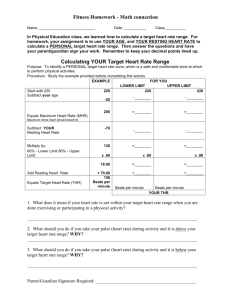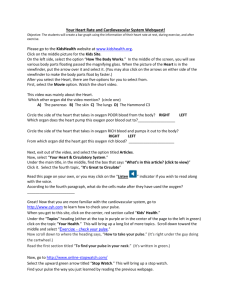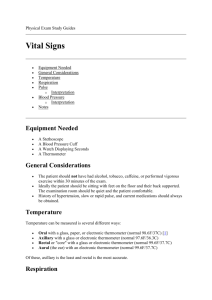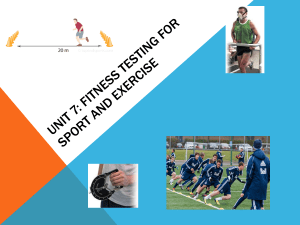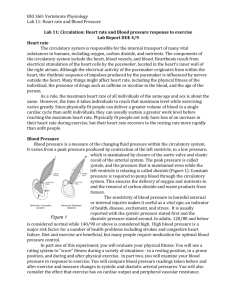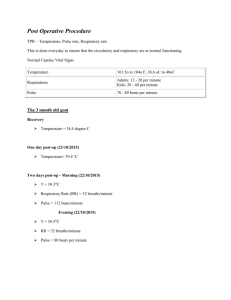AP Lab 23 - Metabolic Rates
advertisement
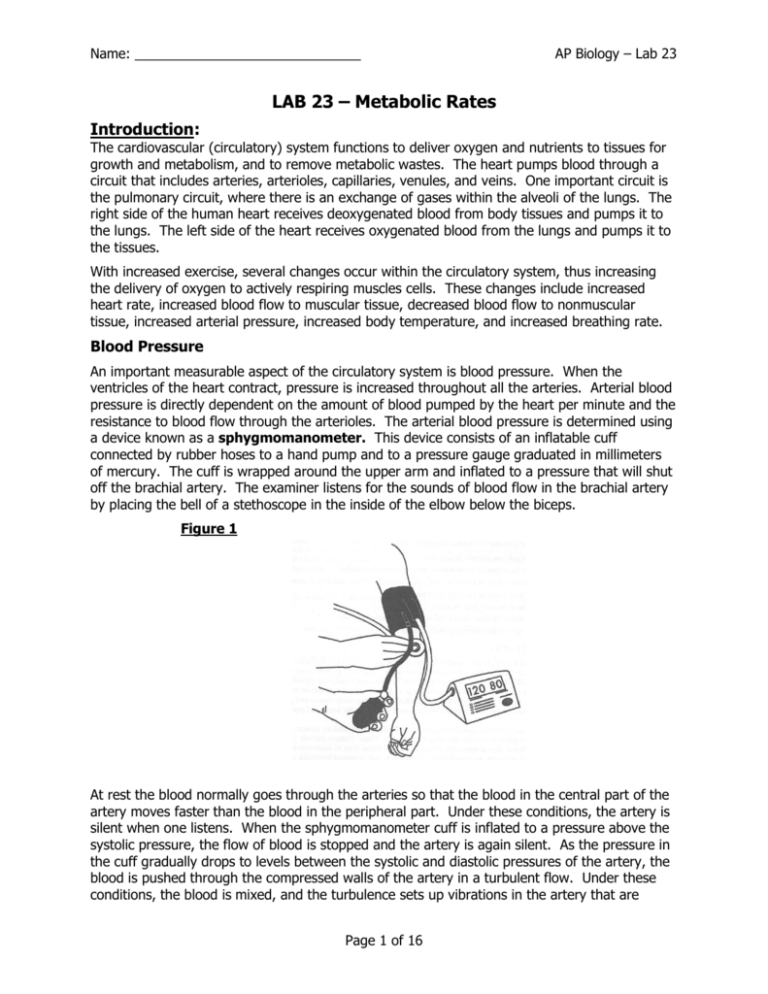
Name: ______________________________ AP Biology – Lab 23 LAB 23 – Metabolic Rates Introduction: The cardiovascular (circulatory) system functions to deliver oxygen and nutrients to tissues for growth and metabolism, and to remove metabolic wastes. The heart pumps blood through a circuit that includes arteries, arterioles, capillaries, venules, and veins. One important circuit is the pulmonary circuit, where there is an exchange of gases within the alveoli of the lungs. The right side of the human heart receives deoxygenated blood from body tissues and pumps it to the lungs. The left side of the heart receives oxygenated blood from the lungs and pumps it to the tissues. With increased exercise, several changes occur within the circulatory system, thus increasing the delivery of oxygen to actively respiring muscles cells. These changes include increased heart rate, increased blood flow to muscular tissue, decreased blood flow to nonmuscular tissue, increased arterial pressure, increased body temperature, and increased breathing rate. Blood Pressure An important measurable aspect of the circulatory system is blood pressure. When the ventricles of the heart contract, pressure is increased throughout all the arteries. Arterial blood pressure is directly dependent on the amount of blood pumped by the heart per minute and the resistance to blood flow through the arterioles. The arterial blood pressure is determined using a device known as a sphygmomanometer. This device consists of an inflatable cuff connected by rubber hoses to a hand pump and to a pressure gauge graduated in millimeters of mercury. The cuff is wrapped around the upper arm and inflated to a pressure that will shut off the brachial artery. The examiner listens for the sounds of blood flow in the brachial artery by placing the bell of a stethoscope in the inside of the elbow below the biceps. Figure 1 At rest the blood normally goes through the arteries so that the blood in the central part of the artery moves faster than the blood in the peripheral part. Under these conditions, the artery is silent when one listens. When the sphygmomanometer cuff is inflated to a pressure above the systolic pressure, the flow of blood is stopped and the artery is again silent. As the pressure in the cuff gradually drops to levels between the systolic and diastolic pressures of the artery, the blood is pushed through the compressed walls of the artery in a turbulent flow. Under these conditions, the blood is mixed, and the turbulence sets up vibrations in the artery that are Page 1 of 16 Name: ______________________________ AP Biology – Lab 23 heard as sound in the stethoscope. These sounds are known as the heart sounds, of sounds of Korotkoff. These sounds are divided into five phases based on the loudness and quality of the sounds. Phase 1. A loud, clear, snapping sound is evident which increases in intensity as the cuff is deflated. In the example shown in Figure 2 this phase begins at a cuff pressure of 120 millimeters of mercury (mm Hg) and ends at a pressure of 106 mm Hg. Phase 2. A succession of murmurs can be heard. Sometimes the sounds seem to disappear during this time, which may be a result of inflating or deflating the cuff too slowly. In the example shown in Figure 2, this phase begins at a cuff pressure of 106 mm Hg and ends a t pressure of 86 mm Hg. Phase 3. A loud, thumping sound, similar to that in Phase 1, but less clear, replaces the murmurs. In the example shown in Figure 2, Phase 3 begins at a cuff pressure of 86 mm Hg and ends at a pressure of 81 mm Hg. Phase 4. A muffled sound abruptly replaces the thumping sounds of Phase 3. In the example shown in Figure 2, this phase begins at a cuff pressure of 81 mm Hg and ends at a pressure of 76 mm Hg. Phase 5. All sounds disappear. Figure 2 Page 2 of 16 Name: ______________________________ AP Biology – Lab 23 The cuff pressure at which the first sound is heard (that is, the beginning of Phase 1) is taken as the systolic pressure. The cuff pressure at which the muffled sound of Phase 4 disappears (the beginning of Phase 5) is taken as the measurement of the diastolic pressure. In the example shown in Figure 2, the pressure would be recorded in this example as 120/76. A normal blood pressure measurement for a given individual depends of the person’s age, sex, heredity, and environment. When these factors are taken into account, blood pressure measurements that are chronically elevated may indicate a state deleterious to the health of the person. This condition is called hypertension and is a major contributing factor in heart disease and stroke. Typical blood pressure for men and women varies with age and fitness (Figure 3). For high school students, the typical range is usually 100-130/70-90. Figure 3: Typical Blood Pressure for Men and Women at Different Ages Age (years) 10 11 12 13 14 15 16 17 18 19 20-24 25-29 30-34 35-39 40-44 45-49 50-54 55-59 60-64 65-69 70-74 Systolic Pressure Men Women 103 103 104 104 106 106 108 108 110 110 112 112 118 116 121 116 120 116 122 115 123 116 125 117 126 120 127 124 129 127 130 131 135 137 138 139 142 144 143 154 145 159 Page 3 of 16 Diastolic Pressure Men Women 69 70 70 71 71 72 72 73 73 74 75 76 73 72 74 72 74 72 75 71 76 72 18 74 79 75 80 78 81 80 82 82 83 84 84 84 85 85 83 85 82 85 Name: ______________________________ AP Biology – Lab 23 Activity 1 – Heart Rate and Temperature In ectothermic animals there is a direct relationship between the rate of many physiological activities and environmental temperature. The rate of metabolism in these animals increases as environmental temperatures increase from approximately 5 C to 35 C. Increasing the temperature by approximately 10 results in a doubling of the metabolic rate. That is why the snake or the lizard can hardly move when it is cold but becomes quite active after warming in the sun. In this exercise, you will observe a species of Japanese killifish, the Medaka (Oryzias latipes) over a range of increasing environmental temperature. You will be able to observe the twochambered heart beat over the duration of the investigation Procedure: 1. Watch the video of the Medaka. You should be able to identify the two-chambered heart. 2. To obtain the heart rate in beats per minute, count the heart rate for 15 seconds then multiply by 4. 3. In Table 1, record the temperature and heart rate for every change in temperature until the end of the video. Table 1: Temperature and Heart Rate Data Temperature Heart Rate (beats/min) Temperature Page 4 of 16 Heart Rate (beats/min) Name: ______________________________ AP Biology – Lab 23 Activity 2 – Measuring Blood Pressure Note: These labs are ONLY for experimental, and not diagnostic, purposes. A sphygmomanometer (blood pressure cuff) is used to measure blood pressure. The cuff, designed to fit around the upper arm, can be expanded by pumping a rubber bulb connected to the cuff. The pressure gauge, scaled in millimeters, indicated the pressure inside the cuff. A stethoscope is used to listen to the individual’s pulse (Figure 1). The earpieces of the stethoscope should be cleaned with alcohol swabs before and after each use. Procedure: 1. Work in pairs. Those who are to have their blood pressure measured should be seated with both shirt sleeves rolled up. 2. Attach the cuff of the sphygmomanometer snugly around the upper arm. 3. Place the stethoscope directly below the cuff in the bend of the elbow joint. 4. Close the valve of the bulb by turning it clockwise. Pump air into the cuff until the pressure gauge reaches 180 mm Hg. 5. Turn the valve of the bulb counterclockwise and slowly release air from the cuff. Listen for a pulse. 6. When you first hear the heart sounds, note the pressure on the gauge. This is the systolic pressure. 7. Continue to slowly release air and listen until the clear thumping sound of the pulse becomes strong and ten fades. When you last hear the full heart beat, note the pressure. This is the diastolic pressure. 8. Repeat the measurement two more times and determine the average systolic and diastolic pressure, then record these values in the blood pressure data table. 9. Trade places with your partner. When your average systolic and diastolic pressure has been determined, record these values in Table 2 below. Table 2: Blood Pressure Data Measurement 1 2 Systolic Diastolic Page 5 of 16 3 Average Name: ______________________________ AP Biology – Lab 23 Activity 3 – A Test of Fitness The point scores on the following tests provide an evaluation of fitness based not only on cardiac muscular development but also on the ability of the cardiovascular system to respond to sudden changes in demand. CAUTION: Make sure that you do not attempt this exercise if strenuous activity will aggravate a health problem. Work in pairs. Determine the fitness level for one member of the part (Tests 1 5) and then repeat the process for the other member. Record all data in the spaces provided and in the Fitness Data Box (Table 9) at the end of this exercise FOR YOUR OWN DATA! Test #1: Standing Systolic Compared with Reclining Systolic Use the sphygmomanometer as you did in Exercise 1 to measure the change in systolic blood pressure from a reclining to a standing position. Procedure: 1. The subject should recline on a lab table for at least 5 minutes. At the end of this time, measure the systolic and diastolic pressure and record these values below. reclining systolic pressure reclining diastolic pressure ________ mm Hg ________ mm Hg 2. Remain reclining for two additional minutes, then stand and immediately repeat the measurements on the same subject (arms down). Record these values below. standing systolic pressure standing diastolic pressure ________ mm Hg ________ mm Hg 3. Determine the change in systolic pressure from reclining to standing by subtracting the standing measurement from the reclining measurement. Assign fitness points based on Table 3 and record in the fitness data box (Table 9) Table 1: Change in Systolic Pressure from Reclining to Standing Change (mm Hg) Fitness Points rise of 8 or more rise of 2-7 no rise fall of 2-5 fall of 6 or more 3 2 1 0 -1 Page 6 of 16 Name: ______________________________ AP Biology – Lab 23 Cardiac Rate and Physical Fitness During physical exertion, the cardiac rate (beats per minute) increases. This increase can be measured as an increase in pulse rate. Although the maximum cardiac rate is generally the same in people of the same age group, those who are physically fit have a higher stroke volume (milliliters per beat) than more sedentary individuals. A person who is in poor physical condition, therefore, reaches his or her maximum cardiac rate at a lower work level than a person of comparable age who is in better shape. Individuals who are in good physical condition can deliver more oxygen to their muscles (have a higher aerobic capacity) before reaching maximum cardiac rate than can those in poor condition. Thus, the physically fit have a slower increase in their cardiac rate with exercise and a faster return to the resting cardiac rate after exercise. Physical fitness, therefore, involves not only muscular development but also the ability of the cardiovascular system to respond to sudden changes in demand. Test #2: Standing Pulse Rate Procedure: 1. The subject should stand at ease for 2 minutes after Test 1. 2. After the 2 minutes, determine the subject’s pulse by using the radial artery. 3. Count the number of beats for 30 seconds and multiply by 2. The pulse rate is the number of beats per minute. Record the data in Table 9. Assign fitness points based on Table 4 and record them in Table 9. Table 2: Standing Pulse Rate Pulse Rate (beats/min) < 71 71-80 81-90 91-100 101-110 111-120 121-130 131 Fitness Points 3 3 2 1 1 0 0 -1 Test #3: Reclining Pulse Rate Procedure: 1. The subject should recline for 5 minutes on a lab table/bench. 2. Determine the subject’s resting pulse rate. 3. Count the number of beats for 30 seconds and multiply by 2. (NOTE: the subject should remain reclining for the next test.) The pulse rate is the number of beats per minute. Record the data in Table 9. Assign fitness points based on Table 5 and record them in Table 9. Page 7 of 16 Name: ______________________________ AP Biology – Lab 23 Table 5: Reclining Pulse Rate Pulse Rate (beats/min) < 61 61-70 71-80 81-90 91-100 101 Fitness Points 3 3 2 1 0 -1 Test #4: Baroreceptor Reflex (Pulse Rate Increase from Reclining to Standing) Procedure: 1. The reclining subject should now stand up. 2. Immediately take the subject’s pulse by counting the number of beats for 30 seconds. Multiply by 2 to determine the pulse rate in beats per minute. Record this value below. The observed increase in pulse rate is initiated by baroreceptors (pressure receptors) in the carotid artery and in the aortic arch. When the baroreceptors detect a drop in blood pressure they signal the medulla of the brain to increase the heartbeat and, consequently, the pulse rate. Pulse immediately upon standing = ________ beats per minute 3. Subtract the reclining pulse rate (recorded in Test 3) from the pulse rate immediately upon standing (recorded above for your subject) to determine the pulse rate increase upon standing. Record the data in Table 9. Assign fitness points based on Table 6 and record them in Table 9. Table 6: Pulse Rate Increase from Reclining to Standing Pulse Rate Increase on Standing (number of beats) 0-10 11-18 19-26 27-34 35-43 Reclining Pulse (beats/min) < 61 61-70 71-80 81-90 91-100 101 Fitness Points 3 3 3 2 1 0 3 2 2 1 0 -1 Page 8 of 16 2 1 0 -1 -2 -3 1 0 -1 -2 -3 -3 0 -1 -2 -3 -3 -3 Name: ______________________________ AP Biology – Lab 23 Test #5: Step Test – Endurance Procedure: 1. The subject should do the following: Place your right foot on an 18-inch high stool. Raise your body so that your left foot comes to rest by your right foot. Return your left foot to the original position. Repeat this exercise 10 times, allowing 3 seconds for each step up. 2. Immediately after the completion of this exercise, measure the subject’s pulse for 15 seconds and record below; measure again for 15 seconds (or 30 if the interval requires it) and record below; continue taking the subject’s pulse and recording the rates at 60, 90, and 120 seconds. Number of beats in the 0-15 second interval ____ X 4 = ____ beats per minute Number of beats in the 16-30 second interval ____ X 4 = ____ beats per minute Number of beats in the 31-60 second interval ____ X 2 = ____ beats per minute Number of beats in the 61-90 second interval ____ X 2 = ____ beats per minute Number of beats in the 91-120 second interval ____ X 2 = ____ beats per minute 3. Observe the time that it takes for the subject’s pulse rate to return to approximately the level that was recorded in Test 2. Record the data in Table 9. Assign fitness points based on Table 7 and record them in Table 9. Table 7: Time Required for Return of Pulse Rate to Standing Level after Exercise Time (seconds) 0-30 31-60 61-90 91-120 121+ 1-10 beats above standing pulse rate 11-30 beats above standing pulse rate Fitness Points 4 3 2 1 1 Page 9 of 16 0 -1 Name: ______________________________ AP Biology – Lab 23 4. Subtract the subject’s normal standing pulse rate (recorded in Test 2) from their pulse rate immediately after exercise (the 0-15 second interval) to obtain the pulse rate increase. Record the data in Table 9. Assign fitness points based on Table 8 and record them in Table 9. Table 8: Pulse Rate Increase after Exercise Pulse Rate Increase Immediately After Exercise (beats) 0-10 11-20 21-30 31-40 41+ Standing Pulse (beats/min) < 71 71-80 81-90 91-100 101-110 111-120 121-130 131 Fitness Points 3 3 3 2 1 1 0 0 3 2 2 1 0 -1 -2 -3 Page 10 of 16 2 1 1 0 -1 -2 -3 -3 1 0 -1 -2 -3 -3 -3 -3 0 -1 -2 -3 -3 -3 -3 -3 Name: ______________________________ AP Biology – Lab 23 Table 9: FITNESS DATA Measurement Test 1: Change in systolic pressure from reclining to standing _____ mm Hg Test 2: Standing Pulse Rate _____ beats/min Test 3: Reclining Pulse Rate _____ beats/min Test 4: Baroreceptor Reflex—Pulse Rate Increase on Standing _____ beats/min Test 5: Step Test Return on Pulse to Standing Rate after Exercise _____ seconds Test 5: Step Test Pulse Rate Increase Immediately after Exercise _____ beats/min TOTAL SCORE Total Score Relative Cardiac Fitness 18-17 16-14 13-8 7 or less Excellent Good Fair Poor Page 11 of 16 Points Name: ______________________________ AP Biology – Lab 23 QUESTIONS and ANALYSIS: 1. Graph the temperature and heart rate data from the Medaka obeservations. a. The independent variable is: _____________________________ Use this to label the X-axis. b. The dependent variable is: _____________________________ Use this to label the Y-axis. Title: ____________________________________ Page 12 of 16 Name: ______________________________ AP Biology – Lab 23 2. Why does temperature affect heart rate in ectothermic organisms? _____________________________________________________________________________ _____________________________________________________________________________ _____________________________________________________________________________ _____________________________________________________________________________ 3. Discuss what results you might obtain if you repeated this experiment two additional times using an endothermic organism starting with the thermoneutral zone of that species and then either increasing (one time) or decreasing (the other time) the environmental temperature. _____________________________________________________________________________ _____________________________________________________________________________ _____________________________________________________________________________ _____________________________________________________________________________ _____________________________________________________________________________ 4. Describe at least three different ways (metabolic or physical) that an endothermic organism can regulate its temperature. _____________________________________________________________________________ _____________________________________________________________________________ _____________________________________________________________________________ _____________________________________________________________________________ _____________________________________________________________________________ _____________________________________________________________________________ _____________________________________________________________________________ Page 13 of 16 Name: ______________________________ AP Biology – Lab 23 5. Calculate Q10 for Medaka at three separate intervals during our investigation. SHOW YOUR WORK BELOW IN THE SPACES PROVIDED! SET UP THE CALCULATIONS! For a 10 C interval, the heart rate Q10 can be calculated using sample data as follows: Q10 = rate at higher temperature rate at lower temperature A general formula that can be used with any temperature interval is: k where: Q10 = k2 1 (10/t2 – t1) t2 = higher measurement temperature t1 = lower measurement temperature k2 = rate at temperature t2 k1 = rate at temperature t1 Interval 1: Interval 2: Interval 3: 6. What do you calculations above tell you about the metabolic rates of Medaka? _____________________________________________________________________________ _____________________________________________________________________________ _____________________________________________________________________________ Page 14 of 16 Name: ______________________________ AP Biology – Lab 23 7. Research and explain why blood pressure and heart rate differ when measured in a reclining position and in a standing position. _____________________________________________________________________________ _____________________________________________________________________________ _____________________________________________________________________________ _____________________________________________________________________________ _____________________________________________________________________________ _____________________________________________________________________________ 8. Research and explain why high blood pressure is a health concern. _____________________________________________________________________________ _____________________________________________________________________________ _____________________________________________________________________________ _____________________________________________________________________________ _____________________________________________________________________________ _____________________________________________________________________________ 9. Research and explain why an athlete must exercise harder or longer to achieve a maximum heart rate than a person who is not as physically fit. _____________________________________________________________________________ _____________________________________________________________________________ _____________________________________________________________________________ _____________________________________________________________________________ _____________________________________________________________________________ _____________________________________________________________________________ Page 15 of 16 Name: ______________________________ AP Biology – Lab 23 10. Research and explain why smoking causes a rise in blood pressure. Cite your resources that you gathered information from below. _____________________________________________________________________________ _____________________________________________________________________________ _____________________________________________________________________________ _____________________________________________________________________________ _____________________________________________________________________________ _____________________________________________________________________________ _____________________________________________________________________________ _____________________________________________________________________________ _____________________________________________________________________________ _____________________________________________________________________________ _____________________________________________________________________________ _____________________________________________________________________________ _____________________________________________________________________________ _____________________________________________________________________________ Sources: Page 16 of 16

